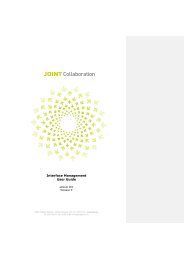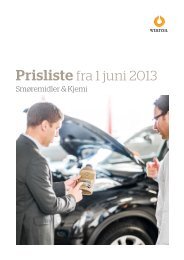Ida Ekblad MarIus Engh anawana haloba lars lauMann - Statoil
Ida Ekblad MarIus Engh anawana haloba lars lauMann - Statoil
Ida Ekblad MarIus Engh anawana haloba lars lauMann - Statoil
You also want an ePaper? Increase the reach of your titles
YUMPU automatically turns print PDFs into web optimized ePapers that Google loves.
an authentic foreign language (an American’s idea of<br />
“Scandinavian”!). Laumann plays the scene “backwards”, which<br />
returns it to its original English.<br />
The increasing obsolescence and strangeness of books,<br />
the relationship between language and text, and the radical<br />
transformation of links between the spoken word and a text<br />
could be said to be themes of this work. For Derrida the<br />
construction of archives and libraries also evokes the notion of<br />
imprisonment. In Archive Fever he writes:<br />
140<br />
Documents at once need a Guardian and a localisation. It is thus,<br />
in this House arrest, that archives take place. 4<br />
Laumann’s recent 3-channel film installation about Nico’s death<br />
(You Can’t Pretend To Be Somebody Else – You Already Are),<br />
a collaborative venture with Benjamin A. Huseby, is a mesmeric<br />
take on the intriguing life and tragically absurd death of<br />
a particularly fascinating cultural icon. Using three male<br />
actors from the London drag collective House of Egypt (each<br />
representing a different stage in her life), Laumann and Huseby<br />
incorporate a dramatised voiceover based on interviews given<br />
by Nico. As the title suggests, this film is essentially about the<br />
collapse of identity, both in its central subject and in the broader<br />
sense. Nico describes how she felt like a moving target and how<br />
she wanted to occupy a “nowhere” space, how she never really<br />
wanted to be a woman. To her, being a woman meant being<br />
judged harshly as a mother, as a heroin addict and as a musician,<br />
with striking disparity in relation to her male counterparts.<br />
Laumann and Huseby negotiate these monologues through<br />
beautifully shot footage in Ibiza – recreating that intense<br />
poetic atmosphere found in the early films of Phillippe Garrel<br />
in which Nico starred. Le Cicatrice Interieure (The Inner Scar),<br />
1971, is the most obvious point of reference, with its dreamlike<br />
scenes of Nico and Garrel wandering aimlessly in the desert,<br />
without any coordinates, lost in an interior world of psychotropic<br />
4. Jacques Derrida, Archive Fever, trans. Eric Prenowitz.<br />
(University of Chicago Press, 1995), 2.<br />
*The deterritorialisation of a major language by means of a minor<br />
literature written in a major language from<br />
a marginalised or minoritarian position.<br />
experimentation. Laumann has told me that Dreyer’s cinematic<br />
world of “dreams within dreams” in Vampyr (1932) was one of<br />
their sources of inspiration. Indeed, when one considers that<br />
Vampyr was based on the Sheridan Le Fanu story Carmilla, itself<br />
a tale of shattered perception and transgressive sexuality, the<br />
connection becomes evident. Laumann and Huseby mine the<br />
layers of cultural mythology attached to Nico: the Warholian<br />
aura she acquired and the sense of timelessness she exuded,<br />
the experimental sexualities espoused at the time of her<br />
involvement with the Velvet Underground, and her dissolution<br />
into a world of anonymity. This elegiac installation (as with so<br />
many of Laumann’s artworks) manages to foster a melancholic<br />
tenderness towards its subject’s complicated persona.<br />
Kari og Knut, Laumann’s new project, uses a variety of media<br />
(including video and a return to found footage) and reflects<br />
once more his great love of literature. He chooses another iconic<br />
figure, that of the elusive J.D. Salinger, to explore issues relating<br />
to both State and personal censorship. Laumann intentionally<br />
draws on the Situationist tactic of “détournement” as developed<br />
by Guy Debord in The Society of the Spectacle, 1967, where<br />
found footage and materials are used subversively for new<br />
ends (a tactic perhaps finding its more recent manifestation in<br />
Deleuze’s conceptualising of a “minoring” strategy*). The title<br />
Kari og Knut refers to a Norwegian nursery rhyme which bears<br />
a close resemblance to the eponymous tale told in The Catcher<br />
in the Rye: Holden’s fantasy of dedicating his life to catching<br />
children as they run towards a cliff to their deaths.<br />
Using films such as Can dialetics break bricks? and<br />
What’s Up, Tiger Lily? as structural precedents, Laumann<br />
appropriates scenes from the 1995 Iranian film Pari by director<br />
Dariush Mehrjui, itself a version of Salinger’s Franny and Zooey,<br />
and replaces the soundtrack with a voiceover by a teenage<br />
Iranian girl berating both Salinger’s self-censorship and State

















